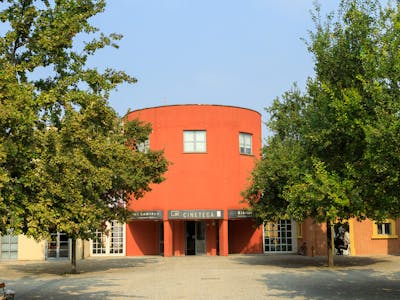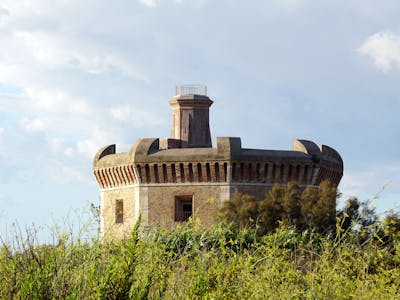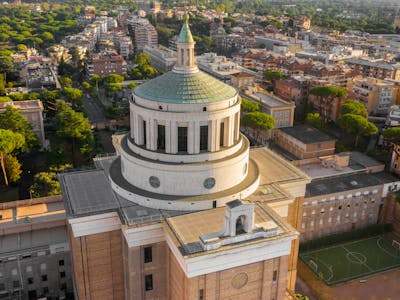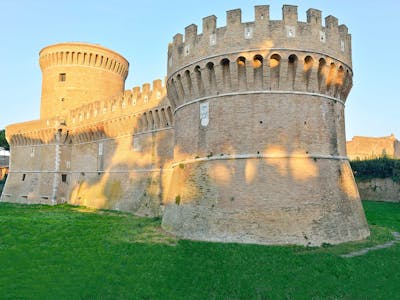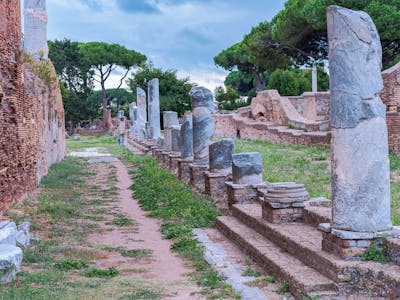Located only fifteen kilometers away from Rome, Ostia Antica is a hidden gem in the countryside and was one of the most important ports and harbor cities of Ancient Rome. With its wonderfully preserved mix of cobbled streets, temples, ruined theaters, villas, shops, apartment blocks, and warehouses, Ostia Antica is one of the few remaining sites that gives you a detailed insight into the lives of the Ancient Romans. Now, that's truly worth a visit!
Ostia Antica in a nutshell
Handy information
| ⏰ Suggested Duration: | 1 -2 hours |
| ☀️ Best Time to Visit: | Summer Mornings |
| 💜 Must See: | Baths of Neptune |
| 🎟️ Ostia Antica Ticket: | €10 |
| 🚇 Closest Metro: | Ostia Antica Station |
Must-see
The House of Diana
The Thermopolium
The Bakery of Silvano
The Theatre
The Piazza of the Corporations
Things to know
Area: 50 hectares
Abandoned: 9th Century AD
Excavation: 1938-1942
Founded by: King Ancus Marcius
Opening Hours And Address
Oct 25 to Feb 28/29 - 8:30 am - 4:30 pm
Mar 1 to Mar 31 - 8:30 am - 5:15 pm
Apr 1 to Sep 30 - 8:30 am - 7 pm
Oct 1 to Oct 24 - 8:30 am - 6 pm
Address : 00119 Rome, Metropolitan City of Rome, Italy
Get Directions
Why you must visit Ostia Antica
- Time Capsule of Ancient Rome: Here, you can walk through the streets, houses, and public buildings, and experience the vibrant life of a bustling metropolis from over 2,000 years ago.
- Archaeological Marvels Unveiled: Know all the secrets of Ostia Antica's extraordinary archaeological finds, including but not limited to beautifully decorated mosaics, intricate frescoes, and grandiose statues that adorn the city's temples, baths, and theaters.
- Roman Urban Planning at its Finest: Discover the ingenious urban layout of Ostia Antica, meticulously designed to accommodate the needs of its diverse population, all a testament to the Roman penchant for order and functionality.
- Explore the Ancient Markets: Ruins of what once must have been a bustling market for textiles and spices still stand today!
Ostia Antica tickets
With your Ostia Antica tickets, you will be able to explore the ancient ruins of the city at your own pace. Your tickets for Ostia Antica include access to its various buildings. These include the theater, the baths, and the temples-all of which are beautifully adorned with frescoes and mosaics.
Ostia Antica's history
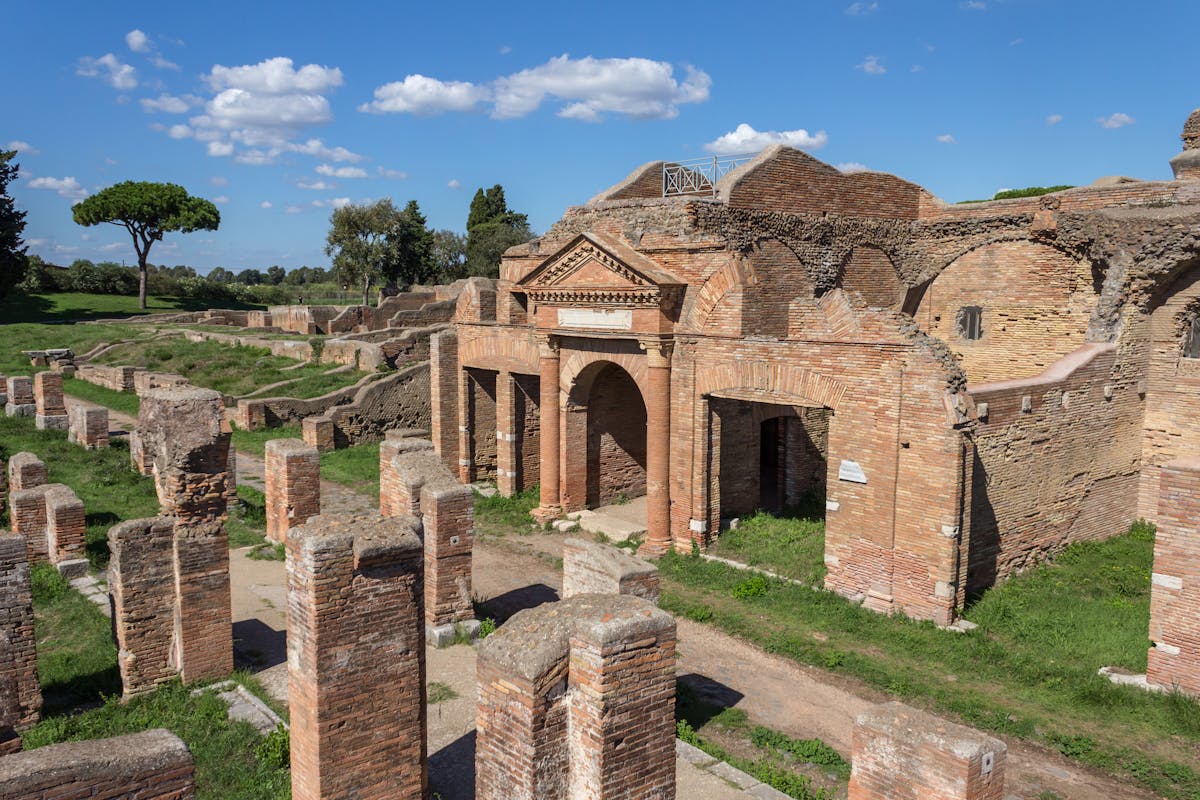
Originally founded as a military camp in the 4th century BC, Ostia Antica grew into a bustling port city, serving as the primary gateway to Rome and a vital hub for trade and commerce. Under the Roman Empire, Ostia Antica was a thriving metropolis, with a diverse population, reflecting the multiculturalism of the empire. Over time, the city witnessed the rise and fall of emperors, endured periods of decline, and ultimately faded into obscurity as the Tiber River shifted, leading to its abandonment in the 5th century AD. Rediscovered in the 19th century, Ostia Antica has since been hailed as one of the best-preserved examples of an ancient Roman city, offering a captivating glimpse into the daily life, architecture, and cultural heritage of the past.
Ostia Antica's excavations
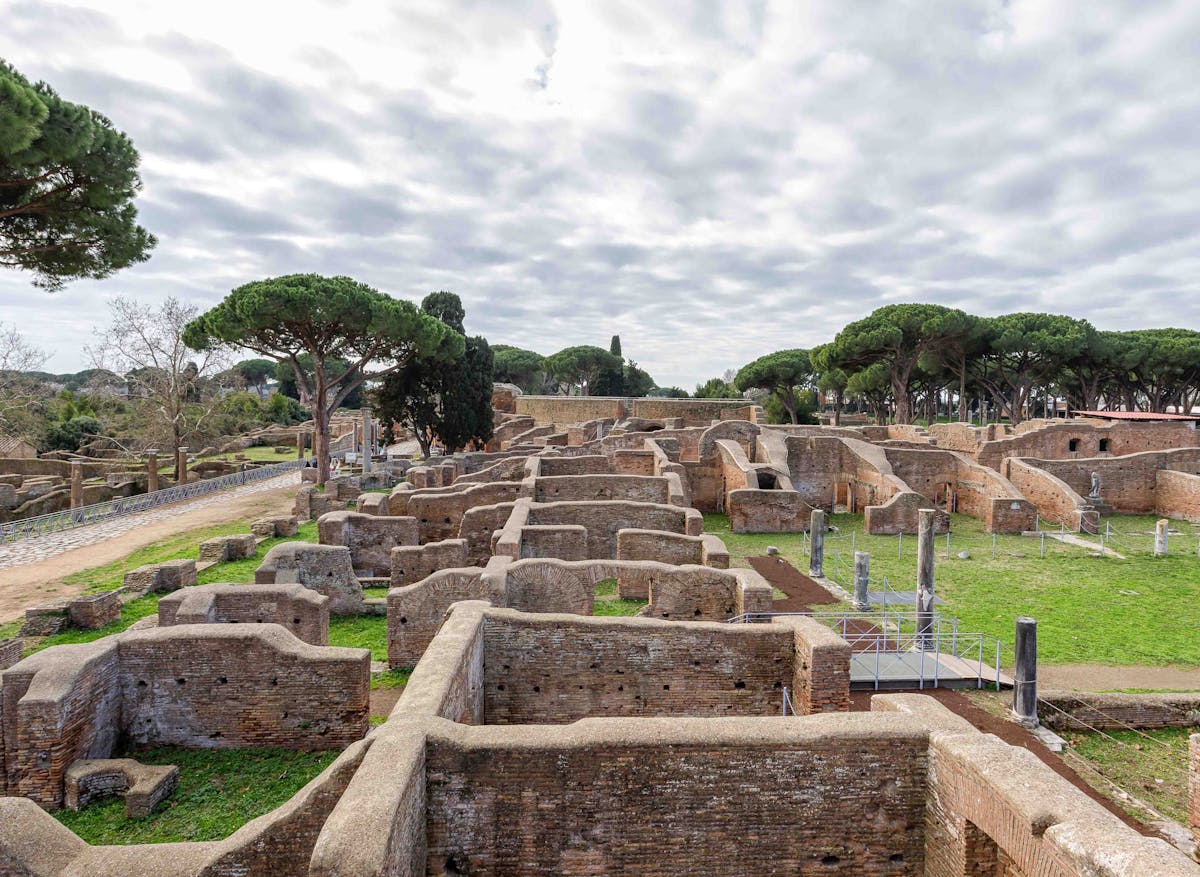
The story of Ostia Antica's excavations is a journey in itself. Early excavations in the 19th century laid the foundation for our understanding of the site's historical significance. However, it was in the 20th century that more systematic and extensive excavations began, shedding light on the city's layout, architecture, and daily life.
Here are some key aspects of Ostia Antica's excavations:
Urban Planning:
One of the most fascinating aspects of the Ostia Antica excavations is the meticulous urban planning of the city. The layout reveals a well-organized grid of streets, marketplaces, temples, and residential areas. The city's architecture showcases the skill and craftsmanship of Roman builders.
Houses and Apartments:
Walking through Ostia Antica's narrow streets, you'll encounter the remains of houses and apartments. These structures provide valuable insights into the daily lives of Ostia's residents, from their social hierarchies to their domestic routines.
Mosaics and Frescoes:
The city boasts some of the finest Roman mosaics and frescoes. These intricate artworks adorn the floors and walls of buildings, depicting scenes from mythology, daily life, and religious rituals. They offer a glimpse into the artistic and cultural tastes of the time.
Public Buildings:
Ostia was not just a residential city; it had an array of public buildings, including temples, bathhouses, and theaters. The excavation of these structures offers a deeper understanding of the city's religious practices, leisure activities, and governance.
Warehouses and a Port:
As a bustling port city, Ostia had extensive warehouses and docks. Excavations of these areas have revealed a wealth of information about the goods traded and the logistics of ancient maritime commerce.
Christianity in Ostia:
The excavations have also uncovered evidence of early Christian communities in Ostia. Several Christian basilicas and catacombs have been found, shedding light on the spread of Christianity in the Roman world.
Ostia Antica highlights
1The Thermopolium
The Thermopolium is an ancient fast food joint that has large windows which open onto the street and give access to the takeaway counter inside the building. In Ancient Rome, this counter would be covered with deep recesses or ‘dolia’ that would be used for storing food and many amphorae that would contain some cheap wine.
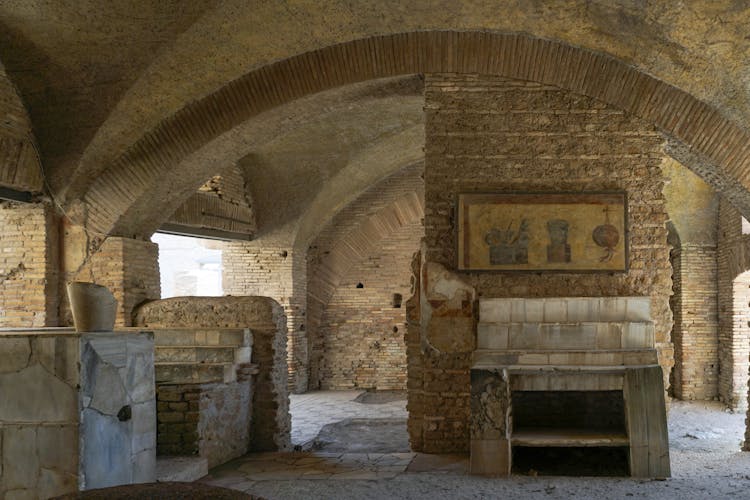
2The Bakery of Silvano
The Bakery of Silvano was built in 120 AD and is located on the Via dei Mulini in Ostia Antica. Bread was a staple diet of the ancient Romans, and the bread made at the bakery was sold to locals and even imported into Rome. Silvano’s bakery had two rooms - one for grinding the grain into flour and the other for kneading the bread dough.
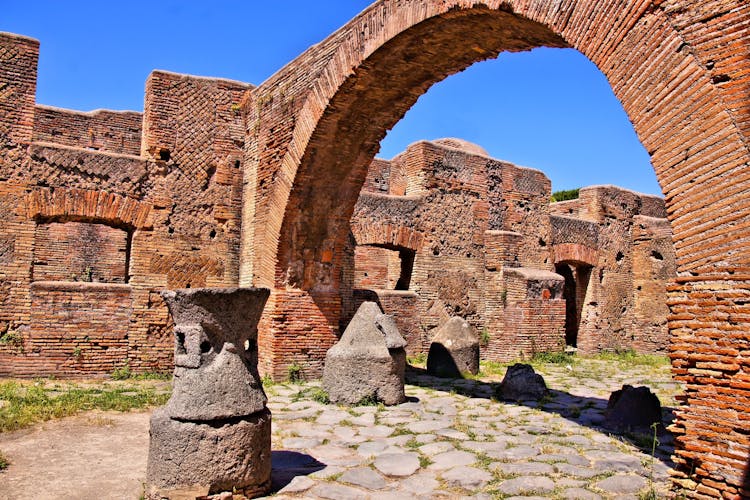
3The Theatre at Ostia Antica
The Theatre at Ostia Antica is one of the oldest masonry theaters in the world. With a holding capacity of four thousand, the Ostia Antica theater survives in excellent condition even today. You can see the four stairways through which the spectators could access the seats in the cavea and the main barrel-vaulted entrance of the Theatre which gave direct access to the level at which the orchestra played.
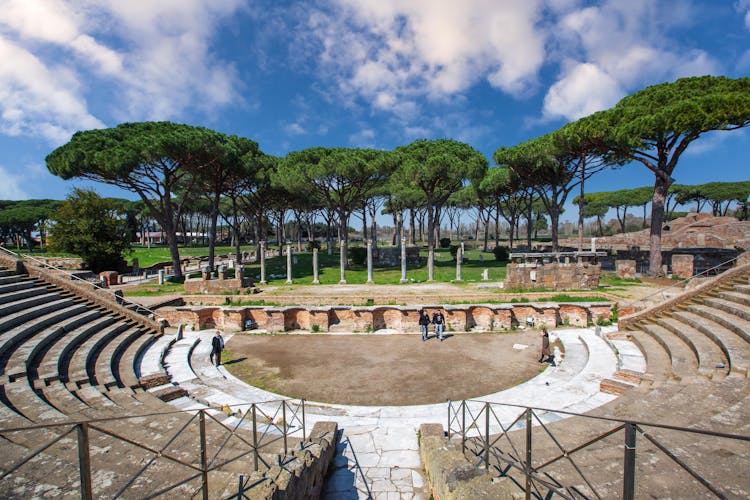
4The Capitolium
Made from brick and built in 120 AD, the Capitolium at Ostia Antica is the main surviving building of the city’s Forum, which was the main civic and religious center of life in ancient Rome. The Capitolium is a large temple dedicated to the Capitoline Triad of Jupiter, Juno, and Minerva. It is also symbolic of the transposition of the official cult of Rome on the new settlement.
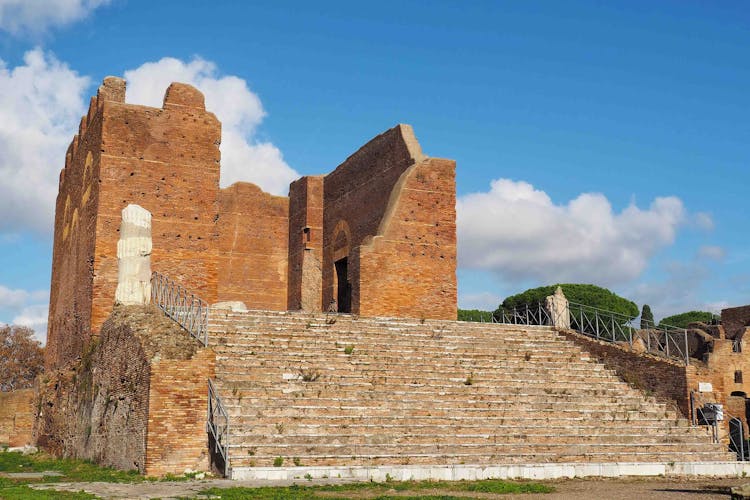
5The Public Latrines of Ostia Antica
The Public Latrines of Ostia Antica are one of the most well-preserved buildings here and showcase Roman plumbing at its finest. Accessed via a revolving door, the Latrines consisted of a communal bench running along three walls with twenty seats. Each of these seats had a hole that led downwards towards a single drainage channel.
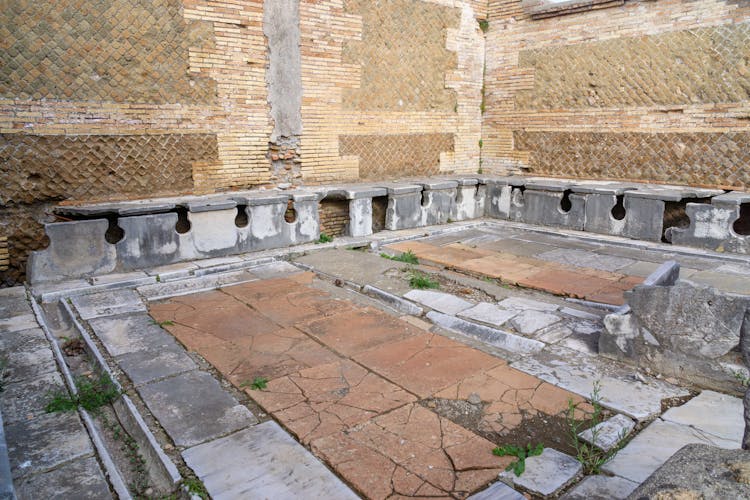
Best time to visit Ostia Antica
You can visit Ostia Antica in Rome all-year round. Since it is located outside, wear something warm and carry an umbrella when you are visiting the site in the winter months. However, you should know that most of the famous mosaics that are found in the building of Ostia Antica are usually covered during the winter months to protect them from the weather.
Ostia Antica - opening hours
Ostia Antica hours
Ostia Antica is open throughout the year from Tuesday to Sunday. The site remains closed on Mondays.
The site is closed on Mondays, 1st January, 25th December, 19th and 26th April, 16th August, and 27th December.
The opening hours of Ostia Antica vary throughout the year.
- Oct 25 to Feb 28/29 - 8:30 am - 4:30 pm
- Mar 1 to Mar 31 - 8:30 am - 5:15 pm
- Apr 1 to Sep 30 - 8:30 am - 7 pm
- Oct 1 to Oct 24 - 8:30 am - 6 pm
Getting there
- By Metro:
Take Line B to the Piramide stop and transfer to Line RL Cristoforo Colombo at the Roma-Ostia station. Get off at the seventh stop which is ‘Ostia Antica’ and you will reach the main entrance of Ostia Antica after a five-minute walk. - By Train:
Take the ‘Lido’ train from the Piramide station in Central Rome or the stations of San Paolo and Eur Magliano. The station where you get off is directly opposite Ostia Antica Park and you can use the footbridge to cross the road and reach Ostia Antica. - By Taxi:
You can book a taxi and directly reach Viale Dei Romagnoli 717, where Ostia Antica is located.
Insider tips for visiting Ostia Antica
- The path inside the archaeological area of Ostia Antica is very bumpy. We recommend you wear comfortable shoes and clothes when visiting the site.
- Book your tickets for Ostia Antica online and in advance. This will help you plan your trip and even save time on the day of your visit.
- Since Ostia Antica is located outdoors, wear warm clothes and carry an umbrella when visiting the ancient city in winter.
- If you are visiting Ostia Antica during the summer, carry a water bottle, a hat, sunglasses, and sunblock with you.
- Small dogs are allowed entry into Ostia Antica, but they must be kept on a leash throughout your visit.
- Avoid buying on-the-spot tickets for Ostia Antica. However, if you do, then you should know that the ticket desk at Ostia Antica closes one hour before the closing time of the park.
- The fastest way to get to Ostia Antica is by taking the train or the metro from central Rome.
- The Ostiense Museum at Ostia Antica is currently closed.
- The use of any kind of drone inside Ostia Antica is strictly prohibited.
Restaurants near Ostia Antica

Located near Ostia Antica, this restaurant still follows the food legacy and recipes of Mama Nerina’s. In fact, your entrance ticket to Ostia Antica also includes a welcome flute and limoncello at the end of your meal in this restaurant.

The restaurant serves Italian, Mediterranean, European, Romana, Lazio and central Italian cuisine. If you want great food at great prices, then check out the Arianna al Borghetto restaurant in Ostia Antica.

Another great restaurant near Ostia Antica is Il Frantoio. The restaurant serves both lunch and dinner. The multi-cuisine restaurant serves a delicious variety of Italian, Romano, Lazio, and Central Italian cuisines.

The chefs at Al Banjniero still follow the recipes of the two grandmothers who founded this restaurant near Ostia Antica. They serve simple dishes that are bursting with delicious flavors. Do try their homemade gnocchi and fettucini.

This restaurant serves delicious Italian and Mediterranean cuisines. Pizzas and seafood are included in their menu as well. The restaurant also has some vegetarian, vegan, and gluten-free options that you can choose from.
Hotels Around Ostia Antica
Luxury and Budget Stays
Things to do around Ostia Antica
Freaquently asked questions about Ostia Antica
If you are traveling from central Rome, you will take around thirty minutes to reach Ostia Antica.
Ostia Antica is open from Tuesdays to Sundays. The park remains closed on all Mondays.
It will take you around two to three hours to explore the ancient city of Ostia Antica.
Yes, small dogs are allowed inside Ostia Antica. However, they must be kept on a leash at all times.
Ostia Antica is one of the most well-preserved cities of Ancient Rome. Some of the main highlights of Ostia Antica include the House of Diana, the Thermopolium, the Capitolium, and the Baths of Porta Marina.



